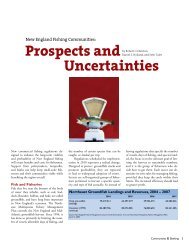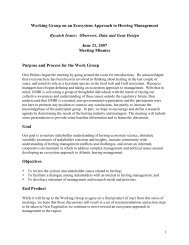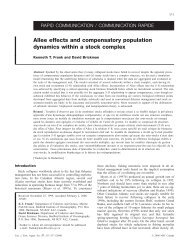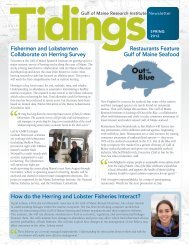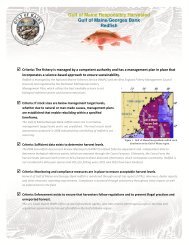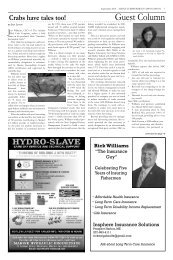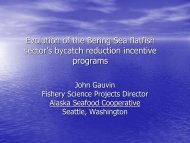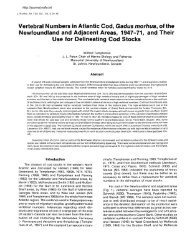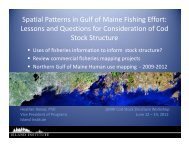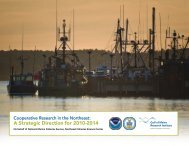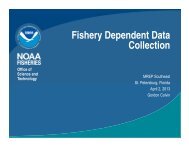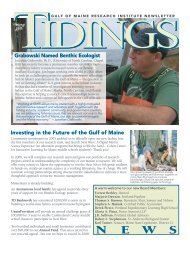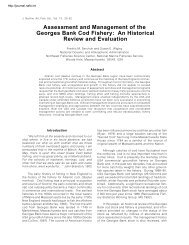Community-based Sectors for the New England Groundfish Fishery
Community-based Sectors for the New England Groundfish Fishery
Community-based Sectors for the New England Groundfish Fishery
You also want an ePaper? Increase the reach of your titles
YUMPU automatically turns print PDFs into web optimized ePapers that Google loves.
4.4 Communities without Catch History<br />
There are a large number of permit holders who have little catch history in recent years. Some of<br />
<strong>the</strong>se permit holders had been inactive <strong>for</strong> some time and were not granted any allocation of “A”<br />
DAS in amendment 13. O<strong>the</strong>rs did receive “A” DAS allocations in 2004 but have not been<br />
actively participating in <strong>the</strong> groundfish fishery since <strong>the</strong>n. Some were leasing out <strong>the</strong>ir DAS to<br />
o<strong>the</strong>r vessels. Additionally <strong>the</strong>re are some communities (including several in Downeast Maine)<br />
that traditionally had some involvement in <strong>the</strong> groundfish fishery, but no longer have any<br />
fishermen with permits with “A” DAS and catch history.<br />
Currently allocation to sectors is <strong>based</strong> solely on catch history. However future sector allocation<br />
may be <strong>based</strong> on factors o<strong>the</strong>r than catch history. For example, allocation of a proportion of TACs<br />
to sectors could be <strong>based</strong> on <strong>the</strong> physical characteristics of <strong>the</strong> vessels and <strong>the</strong>ir DAS allocations.<br />
This would provide some allocation to vessels with little or no catch history, but, it is not clear<br />
whe<strong>the</strong>r that allocation would be provided to vessels without “A” DAS. There<strong>for</strong>e it may still be<br />
necessary <strong>for</strong> communities without current access to <strong>the</strong> groundfish fishery to buy <strong>the</strong>ir way back<br />
into <strong>the</strong> fishery through acquisition of permits.<br />
<strong>Sectors</strong> in conjunction with permit banks could provide an opportunity <strong>for</strong> permit owners and<br />
communities without “A” DAS and catch history to reenter <strong>the</strong> groundfish fishery. Individuals<br />
that hold groundfish permits with only “C” DAS could enter a sector without purchasing a new<br />
permit and could have access to that sector’s allocation. A sector could be created with a permit<br />
bank to acquire catch history <strong>for</strong> this purpose. However, in order to provide communities or<br />
groups of fishermen with sufficient security to make an investment in a permit bank and to<br />
acquire financing, it would be necessary to provide greater assurance of <strong>the</strong> longevity of<br />
allocations associated with fishing permits held by <strong>the</strong> permit bank and clarity on <strong>the</strong> legality of a<br />
community-<strong>based</strong> entity holding permits.<br />
5.0 Conclusions<br />
The current management system <strong>based</strong> on individual ef<strong>for</strong>t (DAS) limits, year-round and seasonal<br />
closures and trip limits has undermined <strong>the</strong> economic viability of many fishing operations and <strong>the</strong><br />
efficiency of <strong>the</strong> overall fleet. Trip limits result in substantial discarding and waste of marketable<br />
fish. Increasingly restrictive DAS limits and trip limits appear to have reduced fishing mortality<br />
on stocks of concern to a below-overfishing thresholds, but <strong>the</strong>y constrain <strong>the</strong> fleet from catching<br />
a substantial proportion of <strong>the</strong> sustainable yield of o<strong>the</strong>r species. The current system has also<br />
created safety concerns by causing vessels to fish in unsafe conditions in order to maximize<br />
revenues from <strong>the</strong>ir limited DAS.<br />
Although <strong>the</strong> inefficiencies of <strong>the</strong> current management system have affected nearly all active<br />
groundfish permit holders, <strong>the</strong> impacts may have been greater in some areas as evidenced by a<br />
shift of landings toward a few larger ports in Massachusetts. This shift is mainly a result of<br />
vessels moving to or landing at ports closer to <strong>the</strong> most productive fishing grounds. However,<br />
groundfish boats in Maine face additional disadvantages, including a prohibition on landings<br />
lobsters caught by trawl gear and <strong>the</strong> state tax on marine fuel which have contributed to a shift of<br />
activity away from Maine. <strong>Groundfish</strong> landings in Downeast Maine have been essentially<br />
49



